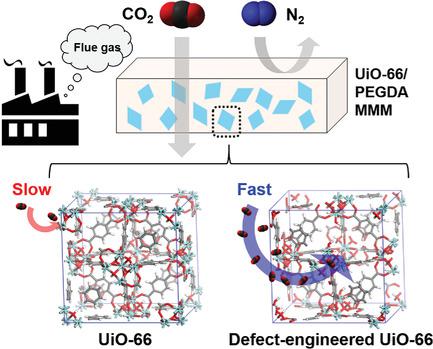当前位置:
X-MOL 学术
›
Adv. Funct. Mater.
›
论文详情
Our official English website, www.x-mol.net, welcomes your feedback! (Note: you will need to create a separate account there.)
Disclosing the Role of Defect-Engineered Metal–Organic Frameworks in Mixed Matrix Membranes for Efficient CO2 Separation: A Joint Experimental-Computational Exploration
Advanced Functional Materials ( IF 19.0 ) Pub Date : 2021-07-08 , DOI: 10.1002/adfm.202103973 Tae Hoon Lee 1 , Aydin Ozcan 2 , Inho Park 1 , Dong Fan 2 , Jun Kyu Jang 1 , Paulo G. M. Mileo 2 , Seung Yeon Yoo 1 , Ji Soo Roh 1 , Jun Hyeok Kang 1 , Byung Kwan Lee 1 , Young Hoon Cho 3 , Rocio Semino 2 , Hyo Won Kim 4 , Guillaume Maurin 2 , Ho Bum Park 1
Advanced Functional Materials ( IF 19.0 ) Pub Date : 2021-07-08 , DOI: 10.1002/adfm.202103973 Tae Hoon Lee 1 , Aydin Ozcan 2 , Inho Park 1 , Dong Fan 2 , Jun Kyu Jang 1 , Paulo G. M. Mileo 2 , Seung Yeon Yoo 1 , Ji Soo Roh 1 , Jun Hyeok Kang 1 , Byung Kwan Lee 1 , Young Hoon Cho 3 , Rocio Semino 2 , Hyo Won Kim 4 , Guillaume Maurin 2 , Ho Bum Park 1
Affiliation

|
Incorporation of defects in metal–organic frameworks (MOFs) offers new opportunities for manipulating their microporosity and functionalities. The so-called “defect engineering” has great potential to tailor the mass transport properties in MOF/polymer mixed matrix membranes (MMMs) for challenging separation applications, for example, CO2 capture. This study first investigates the impact of MOF defects on the membrane properties of the resultant MOF/polymer MMMs for CO2 separation. Highly porous defect-engineered UiO-66 nanoparticles are successfully synthesized and incorporated into a CO2-philic crosslinked poly(ethylene glycol) diacrylate (PEGDA) matrix. A thorough joint experimental/simulation characterization reveals that defect-engineered UiO-66/PEGDA MMMs exhibit nearly identical filler–matrix interfacial properties regardless of the defect concentrations of their parental UiO-66 filler. In addition, non-equilibrium molecular dynamics simulations in tandem with gas transport studies disclose that the defects in MOFs provide the MMMs with ultrafast transport pathways mainly governed by diffusivity selectivity. Ultimately, MMMs containing the most defective UiO-66 show the most enhanced CO2/N2 separation performance—CO2 permeability = 470 Barrer (four times higher than pure PEGDA) and maintains CO2/N2 selectivity = 41—which overcomes the trade-off limitation in pure polymers. The results emphasize that defect engineering in MOFs would mark a new milestone for the future development of optimized MMMs.
中文翻译:

揭示缺陷工程金属-有机框架在混合基质膜中的作用,以实现有效的 CO2 分离:联合实验-计算探索
在金属有机框架 (MOF) 中引入缺陷为操纵其微孔性和功能提供了新的机会。所谓的“缺陷工程”在为具有挑战性的分离应用(例如 CO 2捕获)定制 MOF/聚合物混合基质膜 (MMM) 中的传质特性方面具有巨大潜力。本研究首先研究了 MOF 缺陷对所得用于 CO 2分离的MOF/聚合物 MMM 的膜性能的影响。成功合成高度多孔缺陷工程 UiO-66 纳米粒子并将其掺入 CO 2-亲交联的聚(乙二醇)二丙烯酸酯(PEGDA)基质。一项彻底的联合实验/模拟表征表明,无论其母体 UiO-66 填料的缺陷浓度如何,缺陷设计的 UiO-66/PEGDA MMM 都表现出几乎相同的填料-基质界面特性。此外,与气体传输研究相结合的非平衡分子动力学模拟表明,MOF 中的缺陷为 MMM 提供了主要受扩散选择性控制的超快传输途径。最终,含有缺陷最多的 UiO-66 的 MMM 显示出最强的 CO 2 /N 2分离性能——CO 2渗透率= 470 Barrer(比纯 PEGDA 高四倍)并保持 CO 2/N 2选择性= 41——克服了纯聚合物中的权衡限制。结果强调,MOF 中的缺陷工程将标志着优化 MMM 未来发展的新里程碑。
更新日期:2021-09-16
中文翻译:

揭示缺陷工程金属-有机框架在混合基质膜中的作用,以实现有效的 CO2 分离:联合实验-计算探索
在金属有机框架 (MOF) 中引入缺陷为操纵其微孔性和功能提供了新的机会。所谓的“缺陷工程”在为具有挑战性的分离应用(例如 CO 2捕获)定制 MOF/聚合物混合基质膜 (MMM) 中的传质特性方面具有巨大潜力。本研究首先研究了 MOF 缺陷对所得用于 CO 2分离的MOF/聚合物 MMM 的膜性能的影响。成功合成高度多孔缺陷工程 UiO-66 纳米粒子并将其掺入 CO 2-亲交联的聚(乙二醇)二丙烯酸酯(PEGDA)基质。一项彻底的联合实验/模拟表征表明,无论其母体 UiO-66 填料的缺陷浓度如何,缺陷设计的 UiO-66/PEGDA MMM 都表现出几乎相同的填料-基质界面特性。此外,与气体传输研究相结合的非平衡分子动力学模拟表明,MOF 中的缺陷为 MMM 提供了主要受扩散选择性控制的超快传输途径。最终,含有缺陷最多的 UiO-66 的 MMM 显示出最强的 CO 2 /N 2分离性能——CO 2渗透率= 470 Barrer(比纯 PEGDA 高四倍)并保持 CO 2/N 2选择性= 41——克服了纯聚合物中的权衡限制。结果强调,MOF 中的缺陷工程将标志着优化 MMM 未来发展的新里程碑。



























 京公网安备 11010802027423号
京公网安备 11010802027423号